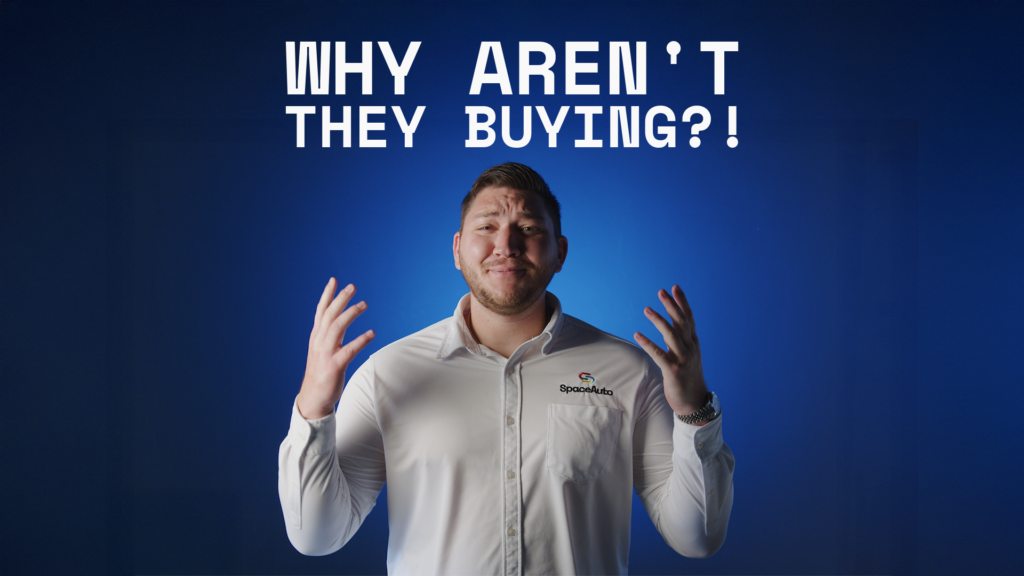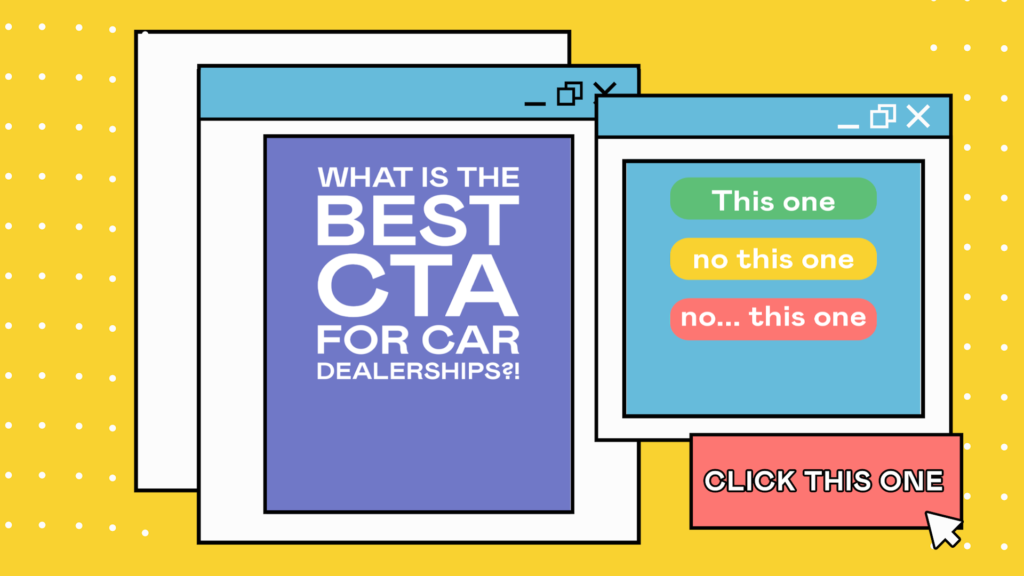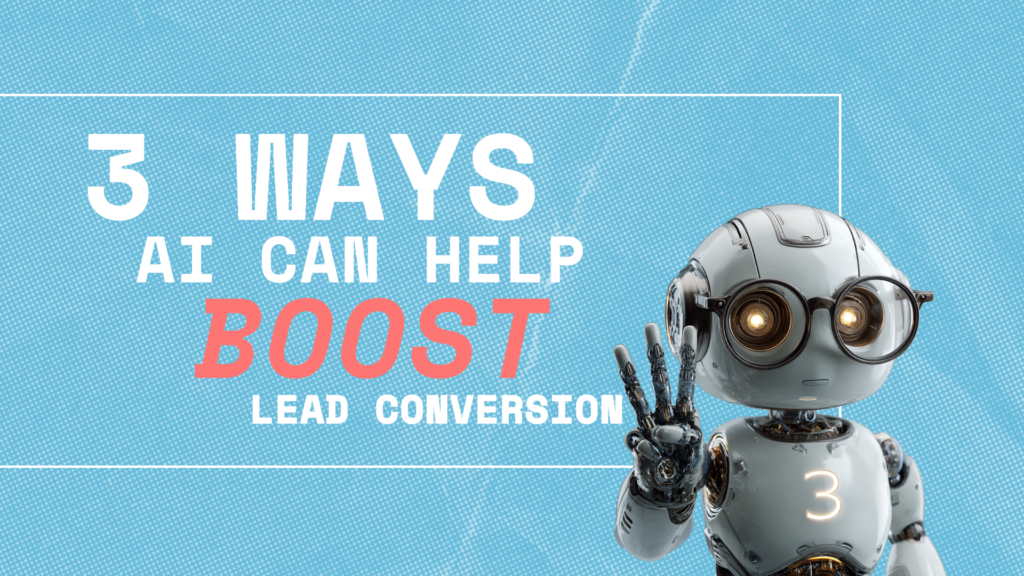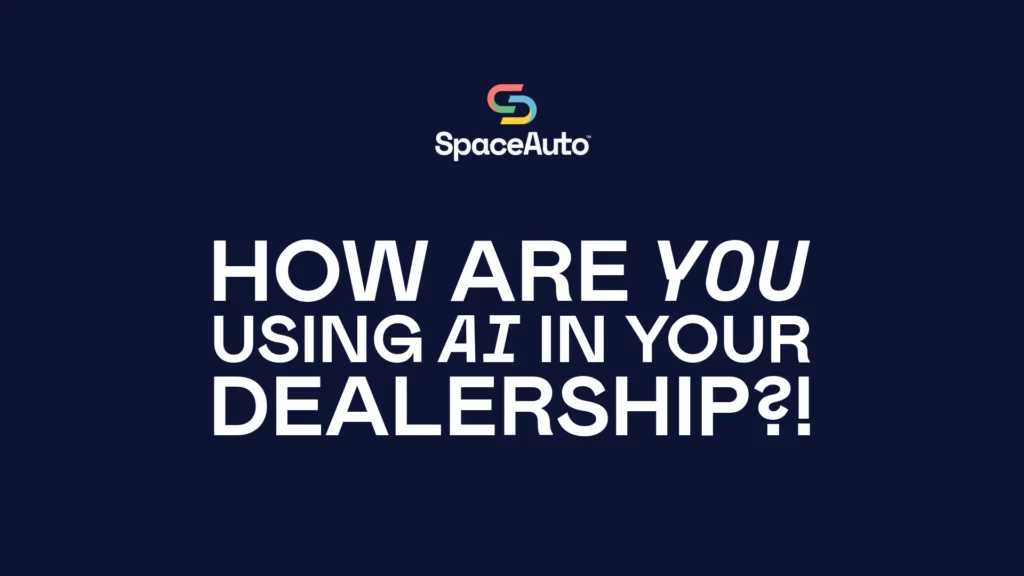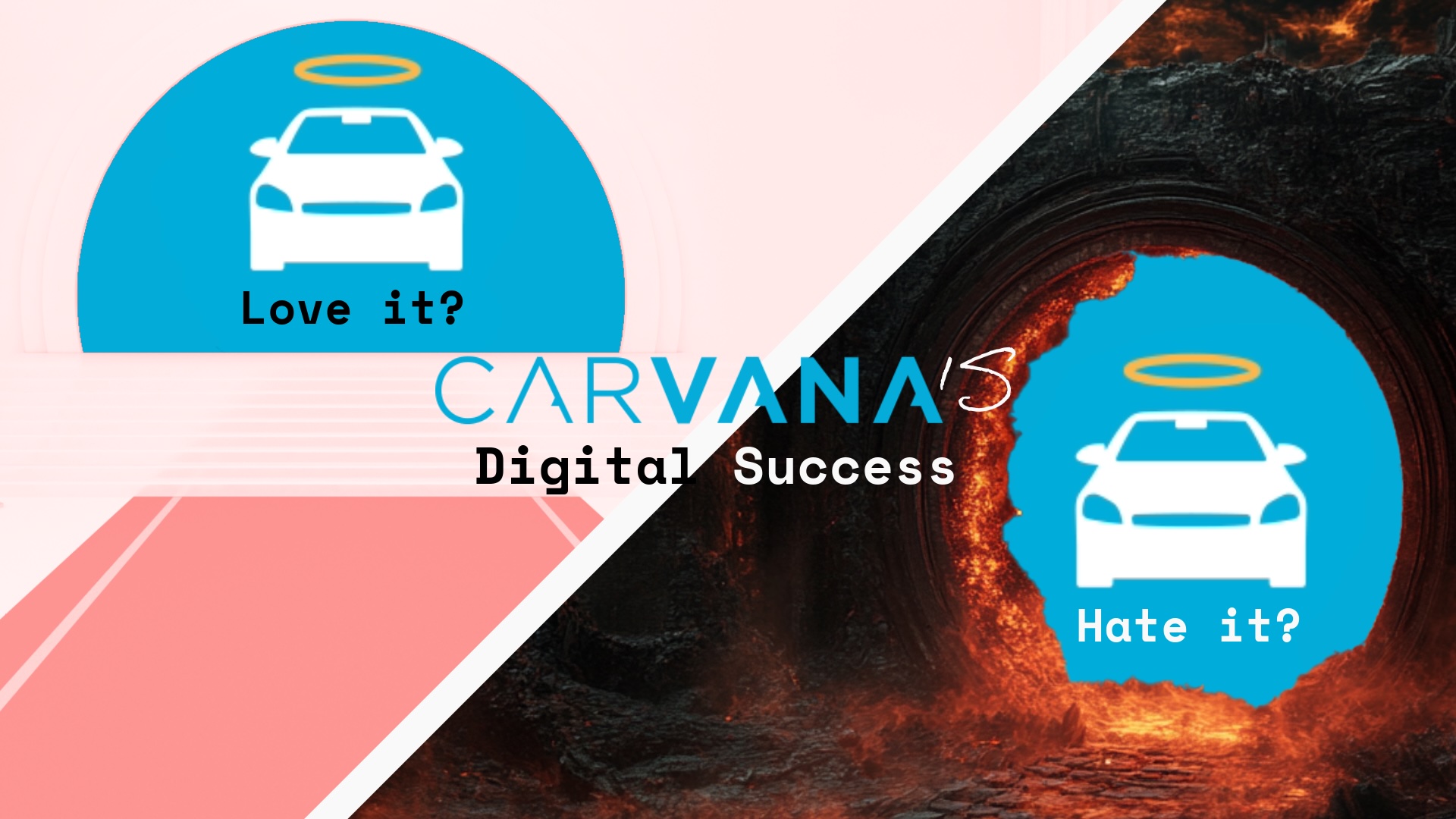
02/25/2025
Building The Best Dealership Website in 2025 – Lessons from Carvana’s Digital Success
In 2025, a seamless mobile customer experience is essential for increasing conversions on dealership websites. The reason is simple – most car shoppers are now browsing inventory, comparing prices, and even completing purchases on their smartphones. If your site doesn’t deliver a fast, easy, mobile-friendly car dealer site experience, shoppers will quickly leave for a competitor (Responsive Design: Why Does Your Site Need to Work Perfectly on All Devices?). Studies show 51% of auto buyers use mobile devices to research dealers and vehicles (Automotive Marketing Statistics 2025 – Everything You Need to Know), and 53% will abandon a site that takes more than 3 seconds to load on mobile (10 Important Website Load Time & Speed Statistics of 2025 – SEOmator). In short, a poor mobile interface means lost leads and sales. Carvana’s meteoric rise – becoming the fastest-growing online used car retailer in the U.S. (Route to Ready: Carvana customer experience – Think with Google) – proves that prioritizing mobile-first design and online convenience can dramatically boost conversion rates and customer satisfaction.
In this post, we’ll explore dealership website optimization strategies for 2025, inspired by Carvana’s digital success. We focus on actionable, best dealership website practices that any dealership can implement with minimal cost. From mobile-first design and personalized AI engagement to high-converting search pages and streamlined buying journeys, these tips will help you enhance user experience and conversions.
- Mobile-First Design: Why a mobile-friendly dealership site is non-negotiable and how to improve yours for free.
- Personalization & AI Engagement: Using personalization and AI in automotive sales to engage customers (chatbots, tailored content, etc.).
- Search & Vehicle Page Simplicity: Designing simplified search results and vehicle detail pages (VDPs) that convert better.
- UX/UI Principles: Applying ergonomic design principles to make your site intuitive and user-friendly.
- Streamlined Buying & Follow-ups: Creating an online buying journey with minimal friction and leveraging AI for quick follow-ups.
Let’s examine each of these in detail, with lessons from Carvana and others on how to turn your website into a high-converting, customer-friendly platform.
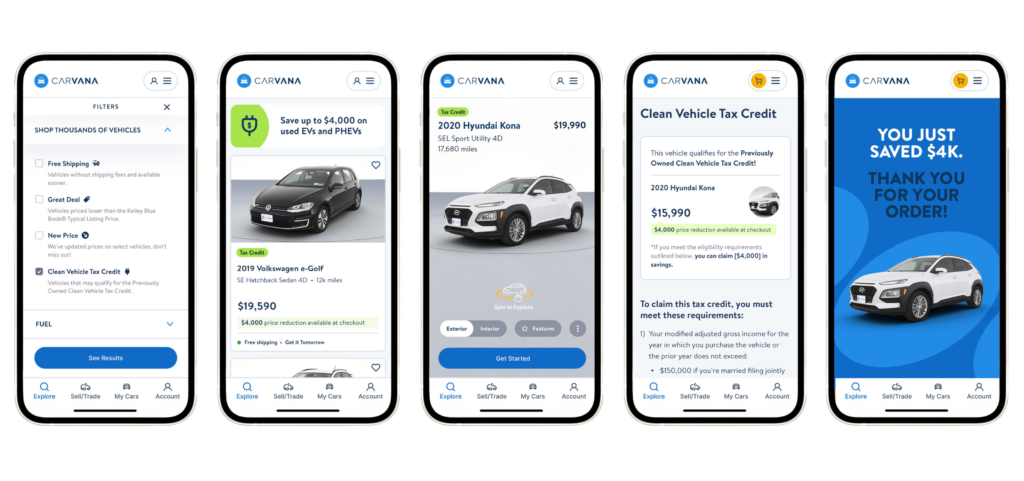
1. Mobile-First Dealership Websites: The Foundation of Conversion
Why Mobile-First Matters in 2025
Mobile is now the primary touchpoint for car shoppers. Recent industry data shows that smartphones account for 1 out of every 2 Google searches related to automobiles, and mobile query volume is surging (up 51% year-over-year) (Automotive Marketing Statistics 2025 – Everything You Need to Know). If your dealership’s website isn’t optimized for mobile, you’re effectively invisible or frustrating to half your potential audience. Moreover, Google has fully shifted to mobile-first indexing, meaning your mobile site performance heavily influences your SEO rankings (Responsive Design: Why Does Your Site Need to Work Perfectly on All Devices?). In other words, mobile-friendly design is not just a user preference, but a search ranking necessity.
Crucially, mobile user experience directly impacts conversion rates. Consumers are impatient on small screens – 53% will leave a mobile site that takes longer than 3 seconds to load (10 Important Website Load Time & Speed Statistics of 2025 – SEOmator). And it’s not just speed; ease of use matters too. Google’s research found 61% of users are unlikely to return to a site if they had trouble accessing it on mobile, and 40% will instead visit a competitor’s site (Responsive Design: Why Does Your Site Need to Work Perfectly on All Devices?). The message is clear: a seamless mobile experience keeps shoppers on your site and moving toward a sale, while a clunky one drives them away (often for good).
Carvana understood this from the start. The company set out to replace the time-consuming dealership visit with a pleasant online experience (Route to Ready: Carvana customer experience – Think with Google). They built their platform with a mobile-first mentality, ensuring customers could browse, finance, and even purchase a car entirely via smartphone or app (Carvana drives increase in site performance and user experience with Fullstory | Fullstory). This convenience factor was key in Carvana’s success – by meeting customers on their devices and terms, Carvana dramatically grew online sales. Their CEO noted that every touchpoint was designed to be “innovative and convenient” to meet rising customer expectations (Route to Ready: Carvana customer experience – Think with Google). The payoff for Carvana was huge: a frictionless mobile experience helped make them the fastest growing online dealer, proving how vital mobile-first design is for conversion.
How to Optimize for Mobile (Actionable Tips)
The good news is that making your site mobile-friendly often costs little or nothing beyond some time and tweaks. Here are actionable steps to create a mobile-friendly car dealer site that keeps users engaged:
- Use Responsive Design: Ensure your website uses responsive design so it automatically adapts to different screen sizes. Test your site on phones and tablets to confirm that text is readable without zooming, buttons are tappable, and no horizontal scrolling is required (key responsive benchmarks (Responsive Design: Why Does Your Site Need to Work Perfectly on All Devices?)). Most modern website platforms have mobile-responsive templates – make sure yours is enabled.
- Speed Up Your Site: Mobile users expect speed. Audit your site with free tools like Google PageSpeed Insights and GTmetrix to identify slow elements. Compress large images (without sacrificing quality), enable browser caching, and eliminate unnecessary scripts or plugins. Every second (or even every few hundred milliseconds) you shave off load time can significantly boost mobile conversion. Remember, nearly half of customers expect pages to load in 2 seconds or less and will bounce if it takes much longer (What’s Different in Website Maintenance in 2025? – OPTASY) (How to Get Your Small Business Found on Google in 2025 – Durable).
- Simplify Navigation: On a small screen, less is more. Use a clear, easy-to-use menu (a simple hamburger menu with key sections like Inventory, Financing, Contact, etc.). Keep forms short and fields minimal – for example, a lead form should ask only essential info. Implement large, thumb-friendly buttons for CTAs (e.g. “Call Now,” “Schedule Test Drive”) so users can easily tap them.
- Persistent CTAs: Speaking of calls-to-action, make sure a CTA is always visible on mobile pages. A great practice is using a sticky footer bar or button that stays at the bottom of the screen (like “View Inventory” or “Email Us”) (10 Easy Ways to Increase Conversions on Your Dealership Website). This way, no matter how far a user scrolls, there’s an easy next step to convert.
- Test Mobile UX Regularly: Periodically do a DIY audit – pretend you are a customer and navigate your site on your phone. How easy is it to find a specific car? Does the site search work well on mobile? Are tap targets sufficiently spaced? You can also use free services like Google’s Mobile-Friendly Test. If you encounter any friction, assume real customers will too, and fix it.
By investing effort into these mobile-first best practices, you’ll likely see more shoppers staying on your site longer and converting. After all, if your site works “like an app” on mobile – fast, intuitive, and delightful – customers will be comfortable taking next steps there (10 Easy Ways to Increase Conversions on Your Dealership Website). In 2025, a dealership website that isn’t mobile-optimized is essentially turning away business, while a seamless mobile experience lays the groundwork for higher engagement and lead conversion.
2. Personalized Experiences and AI-Driven Customer Engagement
Engaging Visitors with Personalization
Modern consumers expect personalized experiences online – and car shoppers are no different. Rather than a one-size-fits-all website, dealers can increase conversions by tailoring the experience to each visitor’s needs and behavior. Personalization can be as simple as dynamically highlighting relevant inventory (for example, showing SUVs on the homepage if a user previously browsed SUVs) or as advanced as recommending vehicles based on a user’s browsing history or purchase intent. The goal is to make each visitor feel the site “gets” what they’re looking for.
Why bother with personalization? Because it works. According to marketing studies, personalized outreach can boost sales leads by 50% (What to Expect in the AI Revolution Happening in Car Dealerships | 2024 Digital Dealer Year in Review | Digital Dealer). When customers see content or offers aligned with their interests, they’re more likely to engage and convert. For example, if a shopper often views budget-friendly used cars, showing a “Vehicles Under $15k” section prominently could prompt them to take the next step. Likewise, returning visitors might appreciate seeing the cars they viewed last time (e.g., “You recently looked at…” reminders) which can lead to a 9% increase in lead conversions through on-site retargeting (10 Easy Ways to Increase Conversions on Your Dealership Website) (10 Easy Ways to Increase Conversions on Your Dealership Website).
Carvana’s platform leverages certain personalization elements that dealerships can emulate. One anecdote from Carvana highlights how they even added surprise gifts (like snorkels and flippers for a mom buying a van for kids’ swim practice) when delivering a car (Route to Ready: Carvana customer experience – Think with Google). While that example is offline, it stems from paying attention to individual customer stories – a mindset that can be applied online. On the website, Carvana provides personalized financing terms after a customer inputs some info, and it remembers saved cars in a user’s wishlist. The lesson is: treat each online shopper individually. Use the data you have (like past visits or lead info) to tailor the content and you’ll see higher engagement.
AI in Automotive Sales: 24/7 Chatbots & Smart Recommendations
Implementing personalization used to require big IT projects, but in 2025 many tools make it easier – often powered by Artificial Intelligence (AI). Embracing AI in automotive sales can significantly enhance customer engagement on your site without breaking the bank. Here are some AI-driven strategies that dealerships (large and small) are using:
- AI Chatbots for Instant Response: An AI chatbot on your website can greet visitors, answer common questions, guide them to inventory, and even schedule appointments any time of day. This is incredibly valuable since many shoppers browse after business hours. Advanced AI chatbots now offer 24/7 customer service, consistently capturing leads and assisting customers even when your staff is offline (What to Expect in the AI Revolution Happening in Car Dealerships | 2024 Digital Dealer Year in Review | Digital Dealer). For example, if someone visits your site at 10pm and asks about financing options, a chatbot can instantly respond with relevant info or collect their contact details for follow-up. This immediate engagement prevents the lead from bouncing to another site for answers. Importantly, basic chatbot functionality can be added for minimal cost – some platforms have free tiers or you can use Facebook Messenger’s free plugin as a simple chat on your site.
- Personalized Vehicle Recommendations: AI can analyze a user’s browsing behavior in real-time and suggest other vehicles they might like (“Customers who viewed this car also looked at…”). This mimics how larger e-commerce sites operate. If a visitor looks at several pickup trucks, your site could automatically feature a few similar trucks or a promotion on truck accessories. These kinds of hyper-targeted campaigns make customers feel understood and can increase engagement significantly (What to Expect in the AI Revolution Happening in Car Dealerships | 2024 Digital Dealer Year in Review | Digital Dealer). While full AI recommendation engines may come with a cost, you can start small: for instance, manually create a “Similar Vehicles” carousel on VDP pages (most dealership website platforms support this) which achieves a similar effect of keeping shoppers browsing relevant inventory.
- AI-Powered Inventory Management: Some dealers leverage AI to manage and update their online inventory listings more intelligently. For example, AI systems can auto-adjust pricing or highlight cars that are getting more interest. While this might be more advanced, even a small dealership can benefit from simpler AI tools – like using an AI service to write better vehicle descriptions based on specs (saving you time and improving SEO with unique content).
- Tailored Content and Emails: AI isn’t limited to the website itself. Dealerships are starting to use AI-driven CRM tools to send personalized follow-up emails or texts. For instance, if a prospect looked at a certain SUV but didn’t convert, an AI CRM could send them an email the next day featuring that SUV and similar models, or even a special offer on SUVs. Personalized follow-up messages can significantly improve lead response rates (more on follow-ups in a later section).
In summary, personalization and AI-driven engagement help transform a static dealer site into an interactive, customer-centric experience. Visitors are more likely to convert when the experience “feels” tailored to them. As one expert noted, dealerships embracing AI in 2025 will lead the charge in delivering seamless, data-driven, highly personalized customer experiences (What to Expect in the AI Revolution Happening in Car Dealerships | 2024 Digital Dealer Year in Review | Digital Dealer). And you don’t need Carvana’s tech budget to do it – start with free or low-cost tools: enable a chatbot, segment your email lists for tailored campaigns, highlight relevant inventory based on user interest. These steps make your website feel less like a generic catalog and more like a helpful personal salesperson.
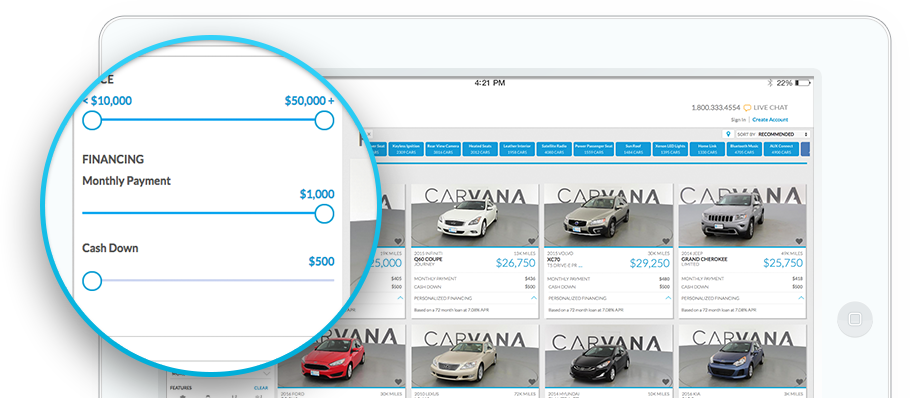
3. Simplified Search and Vehicle Pages for Higher Conversions
Once you’ve attracted a customer to your site (likely on their mobile device, possibly engaged by a chatbot or a targeted campaign), the next crucial step is helping them find the right car quickly and giving them the information that motivates them to convert. This is where your site’s search function and vehicle detail pages (VDPs) play a pivotal role.
Make Search Intuitive and Powerful
For many dealership websites, the search bar is the gateway to the inventory. A well-optimized site search can significantly boost user satisfaction – and conversion. In fact, 43% of website visitors immediately go to the search bar when they arrive, and those who use site search are 2-3 times more likely to convert compared to those who just browse normally (UX Best Practices for Site Search | SearchStax Blog). Shoppers who search know what they want; your job is to help them find it with minimal friction.
Best practices for search UX on a dealership site include:
- Prominent Search Placement: Make the inventory search bar one of the first things users see on the homepage (especially on mobile, it should be visible without scrolling). Use inviting microcopy in the search box like “Search by make, model, or keyword…” to encourage usage.
- Robust Filters (But User-Friendly): Car shoppers like to narrow down by price, body type, year, mileage, etc. Provide easy-to-use filters. On mobile, use collapsible filter menus. Stick to the most commonly used filters to avoid overwhelming the user. According to one UX guide, optimizing and simplifying your search filters can increase engagement and sales – potentially boosting conversions by up to 30% (UX Best Practices for Site Search | SearchStax Blog). Key filters to include: price/monthly payment (more on this below), make/model, year range, mileage, features (sunroof, AWD, etc.), and perhaps color or fuel type for the picky shoppers.
- Allow “Shop by Payment”: Many customers think in terms of monthly budget. If possible, implement a filter or sorting option for payment. For example, a filter that lets users see “$300-$400/month” options (based on price and typical loan terms). As one dealership expert noted, allowing customers to shop by payment “speaks their language” and drastically increases conversion rate because you’re aligning with their actual buying criteria (10 Easy Ways to Increase Conversions on Your Dealership Website). Even if your site platform doesn’t have a built-in payment filter, you can approximate this by creating categories (e.g., a page listing “Cars under $20,000” and noting “≈$350/mo with avg terms”).
- Fast and Tolerant Search: Ensure the search results appear quickly (sub-second if possible). Also, implement tolerance for typos or alternate terms (for example, if someone searches “Camry 2018”, it should still match a “2018 Toyota Camry LE” listing). Many dealer site providers handle this, but test it out. Quick tip: test common searches on your site and see if the results are relevant – if not, consult your provider on improving search relevancy or consider a plugin.
- Clear Results and Sorting: The search results page should display vehicles with key info at a glance: photo, year/make/model, price (or payment), and a highlight of any special feature or discount. Include an option to sort (price low to high, newest arrivals, etc.), but default it to what makes sense for your audience (many default to price low-to-high or featured vehicles on top).
Remember that a smooth search experience directly translates to more leads. A shopper who finds the exact car they want in 3 clicks is much more likely to submit a lead form or call, compared to one who struggles with clumsy filters. As one UX expert put it, “every site search improvement, no matter how small, can have a major impact… something as simple as fast search results can be the difference between a loyal customer and a lost one.” (UX Best Practices for Site Search | SearchStax Blog) Investing a bit of time to fine-tune your search (often just configuration changes with your website provider) can yield significant returns in conversion metrics.
High-Converting Vehicle Detail Pages (VDPs)
Once a shopper lands on a specific vehicle detail page, this is a critical moment. The VDP must build enough trust and excitement for the shopper to take the next step (schedule a test drive, start an online purchase, or submit an inquiry). Here are key strategies to optimize VDPs for conversion:
- Emphasize Visuals (Quality Photos/Video): For car buyers, images are often more important than text descriptions. In a consumer survey, shoppers ranked viewing vehicle photos over 3× more important than reading descriptions, and over 4× more important than reviewing the vehicle history (Lessons from Carvana: The psychology of why used car buyers prefer purchasing online | Snappr For Enterprise Blog). Take a cue from Carvana here: they invested in a 360-degree interactive photo viewer so users can virtually spin the car around and zoom into details (Lessons from Carvana: The psychology of why used car buyers prefer purchasing online | Snappr For Enterprise Blog) (Route to Ready: Carvana customer experience – Think with Google). You might not have proprietary 360 photo tech, but you can still upload 20-30 high-resolution photos per car (exterior from all angles, interior, close-ups of features and any flaws). If possible, add video tours – even a simple walkaround video uploaded to YouTube can boost engagement. The goal is to give online shoppers the next best thing to seeing the car in person. High-quality visuals build confidence and keep users on the page longer, which increases likelihood of conversion.
- Clear Pricing and Payment Info: Be transparent and upfront with pricing on the VDP. List the price clearly (and any discounts or special offers). If you offer online financing or pre-qualification, show an estimated monthly payment. This ties back to the “shop by payment” idea – by showing accurate payment estimates, you tap into the customer’s real purchasing criteria, increasing conversion chances (10 Easy Ways to Increase Conversions on Your Dealership Website). For instance, “$19,500 or ~$320/mo*” (with a note about assumptions). Transparency here builds trust and prevents the user from leaving to calculate payments elsewhere.
- Prominent CTAs (and Multiple Options): Your VDP should always have a visible call-to-action. Typically, this is a “Contact Us” or “Check Availability” form button. Make it stand out (a contrasting color). Many dealers also include secondary CTAs like “Schedule Test Drive,” “Value Your Trade,” or “Get Pre-Approved.” Too many options can be distracting, so prioritize one primary action, but do offer a few choices depending on the customer’s readiness. On mobile, use a sticky bottom bar with a CTA (as mentioned in the mobile section) so the option to convert is constantly present (10 Easy Ways to Increase Conversions on Your Dealership Website). Make sure the form is short and mobile-friendly. Each additional field can reduce form fill rates – name, contact, and maybe one specific question or preferred time is usually enough.
- Trust and Transparency Elements: To convert online, especially for a big purchase like a car, the customer needs trust. Include things that answer their potential doubts directly on the VDP. For example:
- Vehicle History Reports: If a used car, show a link or snapshot of the CARFAX/autocheck report or at least mention “Clean CARFAX – No accidents” if true. Some dealers integrate CARFAX reports directly (worth the cost, as it adds huge trust value).
- Certification/Inspection: If it’s certified pre-owned or you did a 150-point inspection, say so. Bullet-point the certification benefits or warranty coverage right on the page.
- Reviews/Testimonials: Include a banner or blurb like “Don’t just take our word – read our reviews” with a star rating average, or a short testimonial from a happy customer. Social proof helps reassure buyers.
- Guarantees/Return Policy: If you offer any return period or exchange policy (even 3 days, etc.), highlight that. Carvana, for instance, offers a 7-day money-back guarantee instead of a traditional test drive (Route to Ready: Carvana customer experience – Think with Google), and that eases customer fear. While most dealers don’t do 7-day returns, even a “24-hour satisfaction guarantee” or “exchange within X days” could tip a hesitant online buyer in your favor.
- Safety and COVID Info: In current times, some customers care about contactless processes. If you offer home delivery or fully online purchase, mention the safety and convenience (Carvana scaled massively by offering touchless delivery and pickup, meeting customer needs during the pandemic (Route to Ready: Carvana customer experience – Think with Google)).
- Reduce Distractions: Once on a VDP, you want the customer focused on that vehicle. Avoid pop-ups or auto-playing videos that cover the content. Keep the layout clean – plenty of white space, large images, clear sections for description, features, and similar cars. Consider removing or minimizing global navigation on the VDP (some sites use a “micro focus” approach where the header shrinks or disappears while on a vehicle page to keep attention on the car details and the CTA).
- Provide All Key Info Concisely: In addition to visuals and price, make sure to list the important specs (year, make, model, trim, engine, mileage, VIN, etc.) in a well-organized way. Use bullet points for features instead of long paragraphs. Shoppers do read feature lists (e.g., whether it has Apple CarPlay, safety features, etc.), but they prefer skimmable formats. If you have a lot of details, use tabs or accordions (e.g., “Features”, “Specs”, “Warranty”) so the page isn’t overwhelmingly long by default.
A well-optimized VDP can dramatically increase the chances of a conversion. It’s often at the VDP stage that a customer decides to make contact or not. By making the VDP informative, transparent, and easy to act on, you’ll convert more visitors into leads. Also keep in mind: 78% of your website visitors are likely there just to view vehicles (inventory) (10 Easy Ways to Increase Conversions on Your Dealership Website), so these inventory search pages and VDPs are your website’s core product. Make them count. An improvement here is arguably the highest impact optimization you can do.
4. UX/UI Design Principles for an Ergonomic Dealership Website
User Experience (UX) and User Interface (UI) design might sound like buzzwords, but they boil down to one thing: making your website intuitive and enjoyable to use. Good UX/UI design for a dealership website means a visitor can easily accomplish their tasks (research cars, compare, inquire) without confusion or frustration. This section highlights key design principles, many of which are free to implement (just design choices and best practices) that can significantly improve how users perceive and interact with your site.
Clean, Uncluttered Layout
When a potential buyer lands on your homepage or inventory page, they shouldn’t be bombarded with too much information or chaos. Simplicity is key. A clean layout with plenty of white space is easier on the eyes and helps users focus on what matters. Every element on the page should serve a clear purpose (UI Design Best Practices for 2025 – Webstacks). Evaluate your pages: are there banners, ads, or text blocks that aren’t pulling their weight? Removing unnecessary clutter can immediately improve the user experience (and even speed up load times).
- Use Clear Headings and Labels: Make sure your menu labels and page headings are straightforward. For example, label the inventory section as “Inventory” or “Shop Cars” rather than something quirky. Users scan for keywords; use familiar terms (About Us, Contact, Financing, etc.). Each section on a page should have a title (e.g., “Featured Vehicles”, “Customer Reviews”) to set context.
- Mobile Ergonomics: We discussed mobile-first earlier; here we emphasize design specifics. Touch-friendly design is crucial: buttons and links should be big enough for a thumb and spaced so that mis-taps are unlikely (Responsive Design: Why Does Your Site Need to Work Perfectly on All Devices?) (Responsive Design: Why Does Your Site Need to Work Perfectly on All Devices?). Avoid tiny text or buttons that are hard to tap. Also, avoid forcing horizontal scrolling or pinch-zoom on mobile – all content should reflow to vertical scrolling only (Responsive Design: Why Does Your Site Need to Work Perfectly on All Devices?). An ergonomically designed mobile layout significantly reduces user frustration (and as noted, less frustration means users stay – Google found users who have a positive mobile experience are far more likely to convert).
- Fast Loading and Smooth Interaction: Site speed is part of UX. Beyond just load time, ensure that interactive elements don’t lag. For instance, if your site has an image carousel, make sure it swipes smoothly. If something takes a moment (like a payment calculator), use a loading indicator so the user knows to wait. Aim for interactions to feel instantaneous; as Space Auto’s team notes, actions under 100 milliseconds feel “instant” to users’ brains (10 Easy Ways to Increase Conversions on Your Dealership Website). While you can’t achieve that for every action, optimize where you can (e.g., pre-load some data, use efficient code). Quick, responsive interactions contribute to a feeling of quality.
- Accessibility (Inclusivity): An often overlooked aspect: make sure your site is accessible to people with disabilities. This not only widens your audience but also improves overall UX for everyone. Simple steps: add alt text to images (useful for screen readers and also when images fail to load), ensure good color contrast (for visually impaired or color-blind users), and enable keyboard navigation (a user should be able to tab through links and forms logically). These are mostly free adjustments that can also boost your SEO (search engines like accessible sites).
- Avoid Tacky or Intrusive Elements: While pop-ups and flashy banners might grab attention, they often harm UX if overused. Many dealerships have been guilty of immediate newsletter pop-ups or chat windows that cover the whole screen. Use these carefully. For instance, rather than a pop-up that interrupts the user in the first 5 seconds, consider a less intrusive banner or a chat icon that the user can tap when ready. Google’s data shows intrusive interstitials (like full-screen pop-ups) can also hurt your mobile SEO rankings. Aim for a user-first design – if something annoys you when browsing other sites, don’t do it on yours.
Build Trust with Design
Beyond ease of use, good design can increase the trustworthiness of your site, which is crucial for conversion. Users often judge credibility by how professional a site looks. Ensure your site has a modern design (outdated 1990s-looking websites subconsciously turn people off). High-quality graphics, up-to-date content (e.g., don’t showcase a 2017 award on your homepage in 2025 – update it to the latest achievements), and an overall polished look will make users feel more confident in your business.
Consider adding an “About Us” snippet or badge of honors (like “Serving Longview, Texas since 1985” or “Rated 4.8★ by 500 customers”). These can be placed in the footer or sidebar and they humanize your dealership. Also, if you have a chat or contact option, putting a friendly face (photo of a representative) and name can sometimes improve engagement (people like knowing there’s a real human available).
Test and Iterate
Design isn’t one-and-done. Use tools or analytics to see how users interact. For example, you can use free heatmap tools (some have free versions) to see where people click or where they stop scrolling. If you notice, say, few people click on a homepage carousel but many click on a “Used Inventory” link buried in a menu, you might decide to put a used inventory preview on the homepage. Continually refine your design based on user behavior.
In essence, applying solid UX/UI design principles will make your site more ergonomic – meaning it feels easy and natural for users to navigate. This reduces drop-offs and increases the chances that a casual browser becomes an active lead. It’s not a coincidence that Carvana and other successful auto e-commerce platforms invest heavily in UX; they know customer experience is the guiding light for all decisions (Route to Ready: Carvana customer experience – Think with Google). As a dealership, you can adopt the same philosophy on a smaller scale: prioritize the user’s online experience in every design choice, and you’ll see the payoff in engagement and conversions.
5. Streamlined Buying Journeys and AI-Powered Follow-Ups
The ultimate goal of website optimization is to turn interested visitors into actual car buyers. That means your website should not only inform and engage, but also smoothly lead customers through the buying journey – from initial research all the way to purchase – as far as they are willing to go online. And once a potential buyer has raised their hand (by submitting a lead or starting a purchase), your follow-up processes need to kick in effectively. In 2025, that often means leveraging automation or AI to ensure no lead falls through the cracks.
Streamlining the Online Car-Buying Journey
Carvana’s breakthrough was proving that many people are willing to buy cars entirely online if the experience is convenient and trustworthy enough. Traditional dealerships don’t have to copy Carvana’s model exactly, but there are lessons to apply to your own sales funnel to reduce friction:
- Offer Digital Retailing Tools: If possible, enable features that let customers complete more of the purchase process online for themselves. This can include:
- Online Financing Application or Pre-Approval: Integrate a form or link with your financing partners so customers can apply for credit online. Many lenders or dealer software providers offer embeddable forms at low or no cost. If a customer can get pre-approved from their couch, that’s one less hurdle at the store.
- Trade-In Valuation Tool: Provide a free trade-in appraisal tool (e.g., an embedded Kelley Blue Book Instant Cash Offer or similar). This is often free for dealerships to implement (or comes with other services) and generates leads while giving shoppers a transparent idea of their current car’s value. It also engages them to proceed with the deal structure.
- “Buy Now” or Reservation Option: Even if you can’t do the full transaction online, consider a “Reserve this car” for a small deposit, or an “Express Checkout” that allows the customer to fill out all their info and schedule a pickup. Reducing the number of in-person steps saves the customer time and enhances their experience. Space Auto’s research suggests that removing obstacles and allowing customers to build a deal online (with accurate taxes, fees, etc.) helps get them “down the funnel as quickly as possible”, making them happier and more likely to complete the purchase (10 Easy Ways to Increase Conversions on Your Dealership Website).
- Transparent Pricing and Deal Building: Show taxes, fees, and out-the-door pricing in your online process when possible. The number one cause of a bad experience is unmet expectations, so showcasing the most accurate representation of price online creates more happy customers (10 Easy Ways to Increase Conversions on Your Dealership Website). In short, no hidden surprises.
- Online Financing Application or Pre-Approval: Integrate a form or link with your financing partners so customers can apply for credit online. Many lenders or dealer software providers offer embeddable forms at low or no cost. If a customer can get pre-approved from their couch, that’s one less hurdle at the store.
- Simplify the Steps: Analyze your online process – how many clicks or form fields does it take to go from selecting a car to submitting an inquiry or deal? The fewer, the better. For example, don’t force a customer to create an account just to inquire about a vehicle (that extra step might cause drop-off). If you offer an “Express Checkout” for a car, guide them through a logical sequence (select financing, trade-in, contact info, confirm) on as few pages as necessary. Each additional page or complicated step is an opportunity for the customer to abandon the process.
- Provide Guidance and Assurance: Even in a streamlined journey, some customers will have hesitations. Use gentle prompts or FAQs along the way. For instance, on a checkout page, you might have a sidebar FAQ: “What if I change my mind?” with an answer “No worries – you’re not locked in until you sign final paperwork at pickup. You can cancel anytime.” Assure them that they still have control. Carvana famously offers a 7-day return policy (Route to Ready: Carvana customer experience – Think with Google); you might not match that, but even highlighting a “No obligation until you sign” or similar safety net can reduce fear.
- Multi-Channel Continuity: “Meet customers across channels” as Carvana puts it (Route to Ready: Carvana customer experience – Think with Google). This means some customers might start the process online and then want to continue in person or on the phone. Make sure your team is ready to smoothly continue the journey. For example, if an online lead comes in saying they’re interested in stock #1234 and want to finance, your sales team should pick up right where the customer left off (know the vehicle, have their info handy). There’s nothing more frustrating for an online shopper than having to repeat everything when they show up or call. Use your CRM notes diligently to avoid that.
A streamlined digital buying process not only improves customer satisfaction but can directly boost sales. In fact, industry projections suggest that car sales could rise by 25% as a result of enhanced online experiences and streamlined procedures (Automotive Marketing Statistics 2025 – Everything You Need to Know). People buy more when it’s easier to buy. Even if most of your customers still complete the sale in-store, they will appreciate (and be influenced by) the groundwork laid online. A smoother online journey can be the deciding factor that makes a customer choose your dealership over another. It’s all about reducing friction – make it easy for them to say “Yes, I’ll buy from you.”
Fast and Effective Follow-Ups (Leveraging AI)
No matter how great your website is, many customers won’t go all the way to purchase without some human interaction. They might submit a lead form, ask a question, or just stop after browsing. This is where follow-up is critical. A common dealership stat is that speed sells when it comes to lead follow-up. Yet many dealers struggle with slow response times or missed leads. Let’s put some numbers to it:
- The average lead response time in automotive retail is shockingly slow – one study found an average of 47 hours to respond to a web lead (9 Lead Response Time Statistics (2024) – Rep.ai | AI Live Chat, AI Intent, AI Dialer). That’s nearly two days! And worse, only about 27% of leads are ever responded to at all by dealerships (9 Lead Response Time Statistics (2024) – Rep.ai | AI Live Chat, AI Intent, AI Dialer). This represents a huge lost opportunity.
- Conversely, responding quickly has a dramatic impact: contacting a shopper within 5 minutes makes you 10 times more likely to reach them successfully (9 Lead Response Time Statistics (2024) – Rep.ai | AI Live Chat, AI Intent, AI Dialer). If you wait 30 minutes or more, the odds of conversion drop exponentially (after 30 minutes, your chance might be 21 times less effective than if you responded in 5 minutes) (9 Lead Response Time Statistics (2024) – Rep.ai | AI Live Chat, AI Intent, AI Dialer).
- Fast responders win up to 50% of sales (9 Lead Response Time Statistics (2024) – Rep.ai | AI Live Chat, AI Intent, AI Dialer) – meaning if you consistently beat competitors in speed-to-lead, you could capture half of the deals just by being first.
- Consumers now expect fast answers: 82% of consumers expect a response within 10 minutes of an online inquiry (9 Lead Response Time Statistics (2024) – Rep.ai | AI Live Chat, AI Intent, AI Dialer). The bar has been raised by on-demand culture.
These stats underline why follow-up speed and quality are vital. Now, how can a dealership improve in this area, especially with limited staff or after-hours leads? This is where automation and AI can be game-changers at little cost:
- Instant Auto-Responses: At the very least, ensure every lead form or chat submission triggers an immediate email and/or text confirming receipt. This can be a personalized thank-you message: “Thanks for contacting us about the 2018 Honda Civic! A representative is reviewing your inquiry and will reach out to you shortly. In the meantime, here’s a link to the vehicle’s Carfax report and our financing options.” This acknowledgement sets the expectation and gives the customer something to chew on while they wait for a human. Most CRMs or website platforms allow automated responses – set these up if not already in place (it’s essentially free to do).
- AI-Powered Lead Response: Some dealers use AI assistants (like automated text or email responders) that can carry a conversation with the lead until a salesperson takes over. For instance, an AI chatbot could text the customer within 1-2 minutes of an inquiry: “Hi John, I see you’re interested in the 2018 Civic. I’m here to answer any questions. Would you like to schedule a test drive or get info on financing?” If the customer replies, the AI can handle simple Q&A (pricing, availability – pulling from your data) or schedule an appointment. These AI services (provided by companies like Conversica, Fullpath, etc.) often pay for themselves by capturing leads that might otherwise grow cold. Even if you don’t invest in a dedicated AI, consider using something like an FAQ chatbot on email or a preset workflow in your CRM to simulate this – the key is immediate engagement.
- Structured Lead Management and Reminders: Ensure no lead is left behind. Use your CRM to set tasks for follow-up calls, and utilize reminders. Many CRMs have some AI or at least rule-based triggers – for example, if no response was sent to a lead in 1 hour, escalate it or send a second email. Given that about 23.5% of a dealer’s leads receive no follow-up within 24 hours (Automotive Marketing Statistics 2025 – Everything You Need to Know), you can outshine competitors by simply following up consistently. It might be as basic as training staff to treat internet leads with the same urgency as a customer on the lot. A good practice is the “2x2x2” rule – attempt contact 2 times a day for the first 2 days, then once a day for the next 2 days (varying phone, email, text). Many of these touches can be templated (and personalized with the customer’s name/car) so salespeople can send them with one click.
- Use AI for Lead Nurturing: Beyond the initial response, AI can help nurture leads over time. For instance, if a customer inquired but didn’t buy, an AI system could send them new similar listings a week later (“Hi Jane, we just got another 2018 Toyota RAV4 in stock that might interest you, since you were looking at SUVs. Here’s the link…”). This keeps the conversation going. This can also be done manually by setting up saved search alerts for your prospects (some dealership CRMs allow you to enroll leads into automated inventory alerts – effectively using your own inventory data to remarket to them).
- Follow-Up After the Sale (or No Sale): Don’t forget the power of after-sale follow-up for referrals and reviews, but in context of this topic – if a lead doesn’t buy, you can still keep them in a long-term nurture (with AI or automated email campaigns). Maybe they decided to hold off; a few months later, a timely email (“We’ve improved our financing offers this summer – rates from 1.9%! Still interested in upgrading your car?”) could rekindle the conversation. These require some planning but cost virtually nothing per email to send out.
The bottom line is, improve your response time and persistence. Dealerships that contact leads quickly and stay on top of follow-ups have a much higher close rate. In one UK study, the most successful dealership responded to leads in just over 1 minute, and they saw huge gains in test drives and sales as a result (Importance of a Fast Lead Response in the Automotive Industry). While 1 minute might be aspirational, you can aim to consistently be within 5-10 minutes during business hours and have after-hours automation handle the rest.
Leveraging AI and automation ensures that even at 2 AM on a Sunday, your dealership can instantly acknowledge a customer’s request – potentially locking them in before they wander off to another website. As Google’s data suggests, if you’re the first helpful responder, customers are inclined to stick with you, and conversion rates can jump 8X or more if you engage within minutes, compared to waiting hours (Response Time Matters – InsideSales).
In summary, a streamlined buying journey reduces friction up to the sale, and AI-powered follow-ups make sure you capitalize on every opportunity. When combined, these strategies create a seamless continuum: the customer finds your site easy and informative, they start the process with confidence, and if they pause, your systems gently nudge them forward or your team promptly reaches out to assist. This kind of end-to-end optimization is what made Carvana and other digital retailers so successful. Traditional dealerships can adopt the same principles to not only increase online conversions but also to create happier customers who feel supported at every step.
In essence, AI can act like an “extra team member” working 24/7 to engage customers and keep them moving toward a purchase. It’s especially helpful for handling routine tasks at scale (like instant responses or suggesting inventory) so your human team can focus on high-value interactions that actually close deals. Embracing AI in automotive sales efforts can give your dealership a competitive edge in both customer experience and efficiency.
How Do I Build The Best Converting Dealership Website?
In 2025, the best dealership website practices center around one principle: make it easy for customers to shop and engage with you online. A mobile-first approach ensures your site works flawlessly for the majority of shoppers who prefer smartphones. Personalization and AI-driven engagement turn your website into a dynamic, customer-centric experience that builds connection and trust. Simplifying search and vehicle pages helps shoppers find their dream car faster and feel confident enough to take the next step. Solid UX/UI design ties it all together by providing an intuitive, pleasant journey through your digital showroom. And finally, streamlined processes and quick, AI-assisted follow-ups make sure that interest turns into action – and ultimately, sales.
Carvana’s digital success story illustrates what’s possible when you prioritize the online customer experience. While a local dealership may not have Carvana’s resources, the core lessons are absolutely attainable: be fast, be convenient, be transparent, and listen to your customers’ needs. Many of the strategies we discussed – from faster load times to automated lead responses – can be implemented with minimal cost. They mainly require a willingness to adapt and pay attention to what today’s car buyers expect.
By implementing these website optimization strategies, your dealership can improve its conversion rates, generate more leads, and even sell more cars directly or indirectly through your website. Importantly, you’ll also create happier customers. And satisfied customers – who enjoy your seamless website and efficient service – are more likely to become repeat buyers and refer others. In the increasingly digital automotive marketplace, investing in your website’s experience is investing in the future of your dealership.
Remember: every improvement, no matter how small, adds up. As the data and examples have shown, a few seconds faster, a few clicks fewer, or a personalized touch can make the difference between a lost prospect and a loyal customer. So start applying these tips today, and let your dealership website be the powerful sales and marketing tool it’s meant to be.

References: (data and claims sourced from industry studies and expert insights to ensure accuracy and credibility)
- Carvana’s customer-centric digital approach and growth (Route to Ready: Carvana customer experience – Think with Google) (Route to Ready: Carvana customer experience – Think with Google)
- Mobile usage and behavior stats for car shoppers (Automotive Marketing Statistics 2025 – Everything You Need to Know) (Responsive Design: Why Does Your Site Need to Work Perfectly on All Devices?) (10 Important Website Load Time & Speed Statistics of 2025 – SEOmator)
- Impact of site speed and mobile optimization on user behavior (10 Important Website Load Time & Speed Statistics of 2025 – SEOmator) (Responsive Design: Why Does Your Site Need to Work Perfectly on All Devices?)
- Personalization and AI benefits in automotive retail (What to Expect in the AI Revolution Happening in Car Dealerships | 2024 Digital Dealer Year in Review | Digital Dealer) (What to Expect in the AI Revolution Happening in Car Dealerships | 2024 Digital Dealer Year in Review | Digital Dealer) (What to Expect in the AI Revolution Happening in Car Dealerships | 2024 Digital Dealer Year in Review | Digital Dealer)
- Best practices for site search and conversion lift (UX Best Practices for Site Search | SearchStax Blog)
- Importance of high-quality visuals (Snappr study) (Lessons from Carvana: The psychology of why used car buyers prefer purchasing online | Snappr For Enterprise Blog) (Lessons from Carvana: The psychology of why used car buyers prefer purchasing online | Snappr For Enterprise Blog)
- Space Auto’s conversion tips and statistics (10 Easy Ways to Increase Conversions on Your Dealership Website) (10 Easy Ways to Increase Conversions on Your Dealership Website) (10 Easy Ways to Increase Conversions on Your Dealership Website) (10 Easy Ways to Increase Conversions on Your Dealership Website)
- Lead response time statistics and effects on sales (9 Lead Response Time Statistics (2024) – Rep.ai | AI Live Chat, AI Intent, AI Dialer) (9 Lead Response Time Statistics (2024) – Rep.ai | AI Live Chat, AI Intent, AI Dialer) (9 Lead Response Time Statistics (2024) – Rep.ai | AI Live Chat, AI Intent, AI Dialer)
